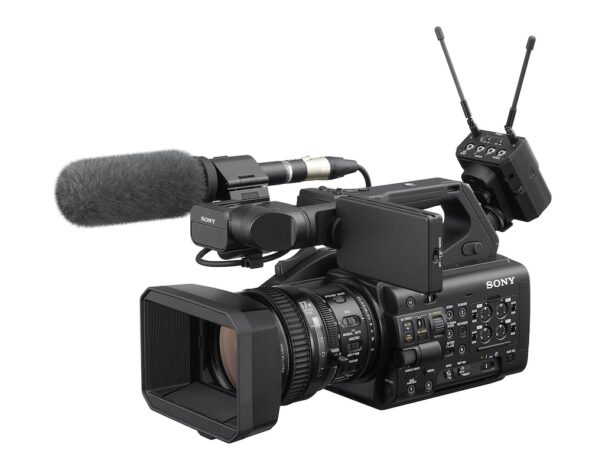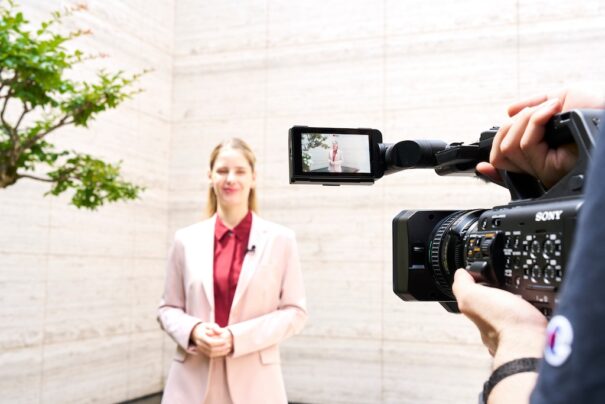Sony PXW-Z300, the new 4K 60P XDCAM camcorder with 17x zoom, 1/2-inch triple CMOS sensor and AI subject tracking
The successor to the popular Z280 and Z200, Sony‘s new PXW-Z300 is a camcorder designed for broadcasters, small production companies and freelancers, featuring a 1/2-inch Exmor R 4K 3-CMOS sensor, digital signature technology for video authentication, advanced networking capabilities and subject recognition using Artificial Intelligence.
The PXW-Z300 combines exceptional image quality, a 17x optical zoom lens, and Electronic Variable ND filter, with versatile operational capabilities. In addition to high-quality 4K 60p recording, it features AI-powered subject recognition for precise autofocus performance. The camera introduces a new articulating Flexible LCD Arm for adaptable capturing styles and a Side V-Mount that allows smartphones or data transmitters to be securely attached.
Image authenticity
With the aim of combating fake news, which is causing so many headaches for broadcasters, one of the highlights of this new camera is the ability to work with digital signatures directly in video files, enabling content authentication to meet the changing needs of the content creation industry, including the growing demand for content authenticity.
Thanks to Sony’s Authenticity Solution technology, it is possible to guarantee the originality of content throughout its traceability, from validating that the recorded object is real and not fake, to validating that the image was taken with that camera, preserving the piece during editing with C2PA application compatibility, verifying the time at which the images were taken, and analysing modifications to any area of the image.
It incorporates a 17x optical zoom lens with F1.9 constant maximum aperture and three independent manual control rings for traditional camera operation. By utilising the digital extender function, individuals can achieve 1.5x zoom in 4K mode and up to 4x zoom in HD mode with minimal degradation, making the camera suitable for a wide range of capturing scenarios, including news gathering and event documentation.
Additionally, the camera is equipped with an Electronic Variable ND filter that seamlessly adjusts transmission from 1/4 to 1/128, along with optical image stabilisation. This allows for smooth brightness adjustment and stable capture when moving between locations with varying light conditions, such as from bright outdoor areas to dim interior spaces.
AI-processing unit
The PXW-Z300 incorporates a dedicated AI-processing unit in addition to its image processing engine. This enables high-precision subject (human) recognition based on face, eye, skeletal structure, and posture information. The system can maintain autofocus on subjects even when they are facing away from the camera or wearing facial coverings. It also features an auto-framing function that automatically adjusts composition to keep human subjects centred in the frame.
The camera also features a 3.5-inch high-brightness LCD monitor with approximately 2.76 million dots. It provides excellent visibility even in bright conditions and is significantly brighter than its predecessor, the PXW-Z280. It incorporates the newly developed Flexible LCD Arm with three-axis movement, which allows flexibility in adjusting the monitor’s position and angle. This enables the camera to accommodate various shooting styles. Operators can adjust the viewing distance when capturing content with the camera on their shoulder, position the LCD monitor at the camera’s optical centre for stable waist-level capture, or flip it forward for self-recording.
New workflows
The camera supports new workflows utilising 5G and cloud technologies, allowing immediate transfer of recorded material from shooting locations and live streaming through smartphone or Wi-Fi/wired LAN connections. Recorded content can be transferred via network to cloud-based media sharing services or on-premises storage in high-quality, efficient formats. For proxy material transmission at lower resolutions, the camera newly supports the HEVC codec, enabling higher quality and compression rates. Additionally, it can transfer clips in chunk format (segmented recording) during shooting. This eliminates the need to remove media and transfer material after shooting, allowing editing to begin as material arrives.
The camera supports common video streaming protocols including RTMP/RTMPS and SRT, enabling live broadcasting from remote locations.
Furthermore, the PXW-Z300 utilises cloud services such as Ci Media Cloud, a cloud-based solution for media collaboration. This allows the camera to support more immediate and efficient video production workflows with material sharing and collaboration among project members, and live streaming with multiple cameras when combined with Sony’s M2 Live Cloud Switcher.
The PXW-Z300 supports various recording formats designed for a wide range of video production applications, including news footage and documentaries. It offers standard support for MXF file recording in formats adopted by the XDCAM series, such as MPEG HD422, XAVC Intra (4K/HD 4:2:2 10bit), and XAVC Long (4K 4:2:0 8bit/HD 4:2:2 10bit), as well as MP4 proxy recording in HEVC.
The camera also accommodates diverse looks. In addition to S-Cinetone, ITU709, and 709tone available in Sony’s Cinema Line series, XDCAM, and HDC series, it supports HLG Live, HLG Mild, HLG Natural, and user 3D LUTs. Users can import custom 3D LUTs (.cube files) from memory cards.
The camera is compatible with Sony’s mobile application Monitor & Control, which supports multi-camera shooting by allowing angle confirmation, camera settings adjustment, and remote operation from smartphones or tablet devices.
Additionally, the camcorder enables the recording of up to four channels of audio – including shotgun microphones and Sony’s UWP-series of wireless microphones – via XLR inputs and the Multi Interface shoe. Future support will provide proxy 4-channel audio recording.
https://www.youtube.com/watch?v=3iTZUuR9DI4
¿Te gustó este artículo?
Suscríbete a nuestro NEWSLETTER y no te perderás nada.





